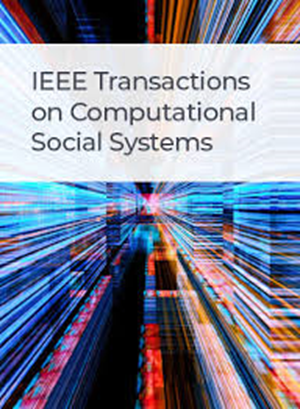TLP-NEGCN:通过网络嵌入和图卷积网络进行时态链接预测
IF 4.5
2区 计算机科学
Q1 COMPUTER SCIENCE, CYBERNETICS
IEEE Transactions on Computational Social Systems
Pub Date : 2024-03-18
DOI:10.1109/TCSS.2024.3367231
引用次数: 0
摘要
时态链接预测(TLP)是网络分析中的一个突出问题,其重点是预测动态网络中实体之间随着时间推移而存在的未来连接或关系。由于难以适应动态网络结构随时间的变化,现有 TLP 模型的预测能力往往受到限制。本文通过利用网络嵌入、图卷积网络(GCN)和双向长短期记忆(BiLSTM),引入了一种改进的 TLP 模型,称为 TLP-NEGCN。这种整合提供了一种稳健的 TLP 模型,它利用历史网络结构并捕捉时间动态,从而提高了性能。我们采用图嵌入与自聚类(GEMSEC)技术,在初始时间戳为网络的所有节点创建低维向量表示。节点嵌入被输入到使用数据集中跨时间戳的 GCN 的迭代训练过程中。这一过程通过捕捉网络的时间动态和整合邻域信息来增强节点嵌入。我们通过串联每条边的末端节点的节点内嵌来获得边内嵌,从而封装网络中节点间关系的信息。随后,通过 BiLSTM 架构对这些边缘嵌入进行处理,以预测网络中即将出现的链接。在各种真实的时间数据集上,将所提出模型的性能与几种基准模型和当代 TLP 模型进行了比较。基于各种评价指标得出的结果证明了所提工作的优越性。本文章由计算机程序翻译,如有差异,请以英文原文为准。
TLP-NEGCN: Temporal Link Prediction via Network Embedding and Graph Convolutional Networks
Temporal link prediction (TLP) is a prominent problem in network analysis that focuses on predicting the existence of future connections or relationships between entities in a dynamic network over time. The predictive capabilities of existing models of TLP are often constrained due to their difficulty in adapting to the changes in dynamic network structures over time. In this article, an improved TLP model, denoted as TLP-NEGCN, is introduced by leveraging network embedding, graph convolutional networks (GCNs), and bidirectional long short-term memory (BiLSTM). This integration provides a robust model of TLP that leverages historical network structures and captures temporal dynamics leading to improved performances. We employ graph embedding with self-clustering (GEMSEC) to create lower dimensional vector representations for all nodes of the network at the initial timestamps. The node embeddings are fed into an iterative training process using GCNs across timestamps in the dataset. This process enhances the node embeddings by capturing the network's temporal dynamics and integrating neighborhood information. We obtain edge embeddings by concatenating the node embeddings of the end nodes of each edge, encapsulating the information about the relationships between nodes in the network. Subsequently, these edge embeddings are processed through a BiLSTM architecture to forecast upcoming links in the network. The performance of the proposed model is compared against several baselines and contemporary TLP models on various real-life temporal datasets. The obtained results based on various evaluation metrics demonstrate the superiority of the proposed work.
求助全文
通过发布文献求助,成功后即可免费获取论文全文。
去求助
来源期刊

IEEE Transactions on Computational Social Systems
Social Sciences-Social Sciences (miscellaneous)
CiteScore
10.00
自引率
20.00%
发文量
316
期刊介绍:
IEEE Transactions on Computational Social Systems focuses on such topics as modeling, simulation, analysis and understanding of social systems from the quantitative and/or computational perspective. "Systems" include man-man, man-machine and machine-machine organizations and adversarial situations as well as social media structures and their dynamics. More specifically, the proposed transactions publishes articles on modeling the dynamics of social systems, methodologies for incorporating and representing socio-cultural and behavioral aspects in computational modeling, analysis of social system behavior and structure, and paradigms for social systems modeling and simulation. The journal also features articles on social network dynamics, social intelligence and cognition, social systems design and architectures, socio-cultural modeling and representation, and computational behavior modeling, and their applications.
 求助内容:
求助内容: 应助结果提醒方式:
应助结果提醒方式:


